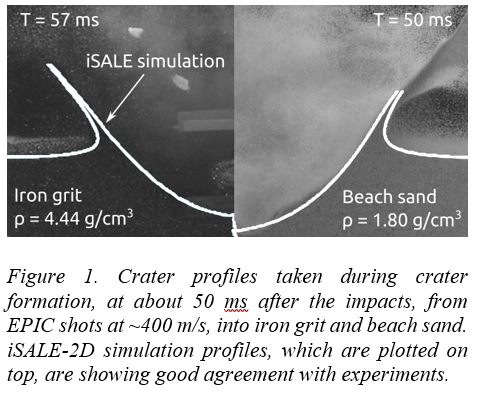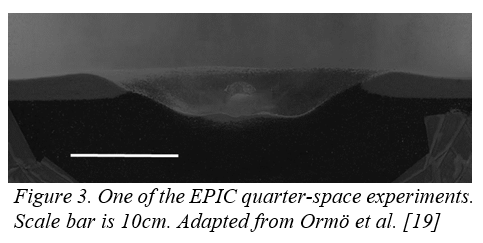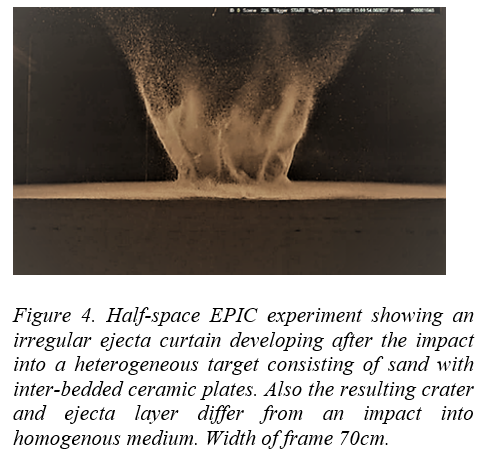Effects of target heterogeneity on impact cratering processes in the light of the Hera mission: combined experimental and numerical approach
- 1Centro de Astrobiologia (INTA-CSIC), Dept Planetology and Habitability, Torrejon de Ardoz, Spain (ormoj@cab.inta-csic.es)
- 2Department of Earth Science & Engineering, Imperial College London, London, UK.
- 3Museum für Naturkunde Berlin, Leibniz Institute for Evolution and Biodiversity Science, Germany
- 4WildFire Lab, University of Exeter
- 5Institute of Geological Sciences, Polish Academy of Sciences
- 6Freie Universität Berlin, Malteserstr. 74-100, 12249 Berlin, Germany
The Double Asteroid Redirection Test (DART) plans to impact the smaller component of the 65803 Didymos asteroid system [1], Dimorphos, and alter the binary orbit period of the system [2]. The experiment aims to demonstrate the controlled deflection capabilities of a near-Earth asteroid. ESA’s Hera mission [1,2] will arrive at Dimorphos four years after the DART impact and provides a detailed characterization of the impact. For a successful analysis it is important to know the influence of various parameters known to affect the cratering. Here we present some preliminary results as well as planned experiments at the Experimental Projectile Impact Chamber (EPIC) at Centro de Astrobiología CSIC-INTA, Spain, carried out in concert with observations of natural craters and numerical simulations for mutual verification of the methods and a first analysis of the effects of factors such as heterogeneities in a granular (i.e. ‘rubble-pile’) target.
Introduction, aim and methods
As shown by previous impact experiments and numerical simulations [3,4,5], the amount by which the target asteroid can be deflected is highly dependent on the target properties and structure, and non-unique. Thus, the knowledge of the final crater as observed by Hera is important to assess the target properties of Dimorphos [6]. However, such an analysis based on numerical models requires accurate validation of the applied numerical codes [7,8]. Previous validation work has focused on impacts into homogeneous targets [e.g. 9,10]. However, it is unlikely that asteroids are as homogeneous at this scale [cf. 11] as on the scale of previous laboratory experiments. Therefore, there is a need for impact experiments specifically designed to mimic asteroid surface materials and structures (e.g. layered targets, rubble piles). The EPIC can be used to provide the impact experiments needed. In addition, field observation of relevant natural craters, both strength-controlled (e.g. Kaali, 110m) and gravity-controlled (e.g. Lockne, 7.5km) may provide additional information.
The EPIC utilizes a 20mm calibre compressed N2 (300bar) cannon that can shoot projectiles of various materials and composition (e.g., solid, clustered) at velocities of up to ~420m/s and into various target materials at impact angles from 20-90° over the horizontal. The experiments, half- or quarter-space, are recorded by high speed cameras, and the resulting craters (approx. 30cm in dry sand) can be scanned in 3D with 0.5mm resolution.
For the results shown here, we use the iSALE shock physics code [12,13] to simulate the conducted experiments from the laboratory. The strengths of iSALE are the availability of: different material models (brittle/ductile rheology), a damage model, various equations of state, and a porosity compaction model.
Planned activities and preliminary results
Vertical impact experiments into homogeneous targets can be used to validate ejecta curtain formation and final crater size from 2D numerical models. Then, simulations can be used to determine the influence of specific material properties in systematic parameter studies, which are difficult to be conducted in the laboratory (Fig. 1).

Most small bodies in the Solar System are not homogeneous, as shown by past missions to asteroids. Several visited asteroids have been observed to be covered by a layer of regolith, which overlies a much stronger or denser substrate [14]. The effects of target layering on impact cratering in the strength regime was studied extensively through laboratory experiments [e.g. 15] and simulations [16]. While much of the kinetic energy of the projectile is released in the weaker upper target, this material also requires relatively less energy to be cratered. Likewise, differing impedances of the cover layer and the substrate (i.e., basement) could result in reflection of the shock, with a reduction of the energy transferred into the basement and, consequently, more energy available for cratering the upper layer. Therefore, the crater in the weak layer may get relatively wider than a corresponding crater in an equivalent homogeneous material. For asteroids like Dimorphos the transition crater diameter will be well above the size of the target, giving that all impacts would be strength dominated. Nevertheless, even in the case of a strength dominated substrate, a layer of granular cohesionless material will still be gravity-dominated. For example, Hayabusa2’s SCI experiment created a concentric crater morphology specific to layered targets, which is believed to have formed in the gravity regime [11]. Layering affects also large gravity-dominated craters [17]. However, little is known about impact cratering into layered targets in the gravity regime.
As shown from numerical simulations into layered targets in the strength-regime, the presence of a stronger and/or denser substrate can both amplify and reduce the momentum transferred from a spacecraft for deflecting an asteroid. [6] This can have important implications for NASA’s DART mission.
We have already carried out some experiments at the EPIC with layers of different density (i.e., beach sand over iron grit) to simulate gravity-controlled cratering in layered targets (Figs. 2,3).

3. Complex target structures/Rubble piles
However, the variations in strength and density can also be compared to the configuration of greatly heterogeneous objects such as rubble-piles. Rubble-pile asteroids may have a highly irregular distribution of massive rock vs rubble (i.e. not in an orderly “layered” fashion), and strength and density vary locally. An irregular crater growth and, consequently, irregular ejection of material affect the asteroid deflection (e.g. unpredictable motions). Such irregularities may be difficult to model numerically and would require full 3-dimensional geometry, which is computationally expensive.
Nevertheless, current efforts to model rubble pile geometries in the context of the DART impact are undertaken [18]. Laboratory experiments are highly needed to validate such models. We intend to investigate these effects experimentally for both strength and gravity dominated targets (Fig. 4).

Acknowledgements
Ormö was supported by grants ESP2017-87676-C5-1-R from the Spanish Ministry of Economy and Competitiveness and Fondo Europeo de Desarrollo Regional. Ormö and Herreros were supported by the Spanish State Research Agency Project No.MDM-2017-0737 Unidad de Excelencia "María de Maeztu"- Centro de Astrobiología (INTA-CSIC), and the CSIC I-LINK project LINKA20203.
How to cite: Ormö, J., Raducan, S. D., Luther, R., Herreros, M. I., Collins, G. S., Losiak, A., and Wünnemann, K.: Effects of target heterogeneity on impact cratering processes in the light of the Hera mission: combined experimental and numerical approach, Europlanet Science Congress 2020, online, 21 September–9 Oct 2020, EPSC2020-922, https://doi.org/10.5194/epsc2020-922, 2020

